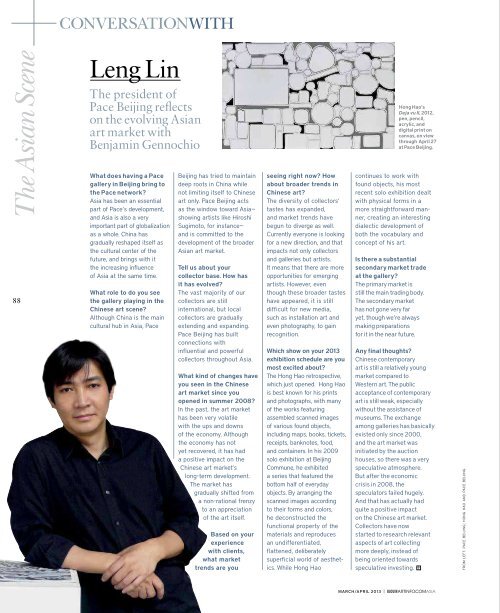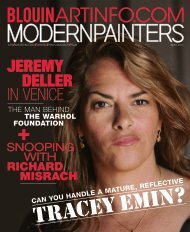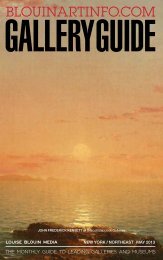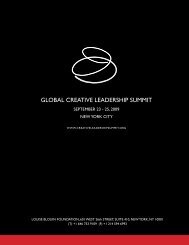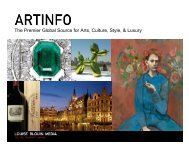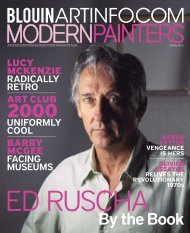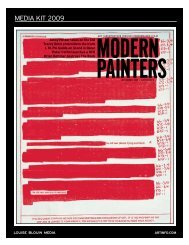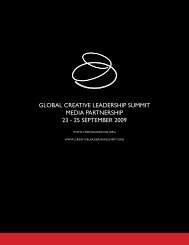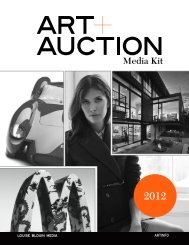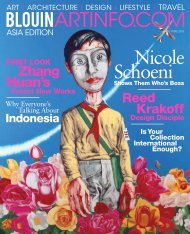Linke - Artinfo
Linke - Artinfo
Linke - Artinfo
Create successful ePaper yourself
Turn your PDF publications into a flip-book with our unique Google optimized e-Paper software.
The Asian Scene<br />
88<br />
conversationwith<br />
Leng Lin<br />
The president of<br />
Pace Beijing reflects<br />
on the evolving Asian<br />
art market with<br />
Benjamin Gennochio<br />
What does having a Pace<br />
gallery in Beijing bring to<br />
the Pace network?<br />
Asia has been an essential<br />
part of Pace’s development,<br />
and Asia is also a very<br />
important part of globalization<br />
as a whole. China has<br />
gradually reshaped itself as<br />
the cultural center of the<br />
future, and brings with it<br />
the increasing influence<br />
of Asia at the same time.<br />
What role to do you see<br />
the gallery playing in the<br />
Chinese art scene?<br />
Although China is the main<br />
cultural hub in Asia, Pace<br />
Beijing has tried to maintain<br />
deep roots in China while<br />
not limiting itself to Chinese<br />
art only. Pace Beijing acts<br />
as the window toward Asia—<br />
showing artists like Hiroshi<br />
Sugimoto, for instance—<br />
and is committed to the<br />
development of the broader<br />
Asian art market.<br />
Tell us about your<br />
collector base. How has<br />
it has evolved?<br />
The vast majority of our<br />
collectors are still<br />
international, but local<br />
collectors are gradually<br />
extending and expanding.<br />
Pace Beijing has built<br />
connections with<br />
influential and powerful<br />
collectors throughout Asia.<br />
What kind of changes have<br />
you seen in the Chinese<br />
art market since you<br />
opened in summer 2008?<br />
In the past, the art market<br />
has been very volatile<br />
with the ups and downs<br />
of the economy. Although<br />
the economy has not<br />
yet recovered, it has had<br />
a positive impact on the<br />
Chinese art market’s<br />
long-term development.<br />
The market has<br />
gradually shifted from<br />
a non-rational frenzy<br />
to an appreciation<br />
of the art itself.<br />
Based on your<br />
experience<br />
with clients,<br />
what market<br />
trends are you<br />
seeing right now? How<br />
about broader trends in<br />
Chinese art?<br />
The diversity of collectors’<br />
tastes has expanded,<br />
and market trends have<br />
begun to diverge as well.<br />
Currently everyone is looking<br />
for a new direction, and that<br />
impacts not only collectors<br />
and galleries but artists.<br />
It means that there are more<br />
opportunities for emerging<br />
artists. However, even<br />
though these broader tastes<br />
have appeared, it is still<br />
difficult for new media,<br />
such as installation art and<br />
even photography, to gain<br />
recognition.<br />
Which show on your 2013<br />
exhibition schedule are you<br />
most excited about?<br />
The Hong Hao retrospective,<br />
which just opened. Hong Hao<br />
is best known for his prints<br />
and photographs, with many<br />
of the works featuring<br />
assembled scanned images<br />
of various found objects,<br />
including maps, books, tickets,<br />
receipts, banknotes, food,<br />
and containers. In his 2009<br />
solo exhibition at Beijing<br />
Commune, he exhibited<br />
a series that featured the<br />
bottom half of everyday<br />
objects. By arranging the<br />
scanned images according<br />
to their forms and colors,<br />
he deconstructed the<br />
functional property of the<br />
materials and reproduces<br />
an undifferentiated,<br />
flattened, deliberately<br />
superficial world of aesthetics.<br />
While Hong Hao<br />
Hong Hao's<br />
Deja vu II, 2012,<br />
pen, pencil,<br />
acrylic, and<br />
digital print on<br />
canvas, on view<br />
through April 27<br />
at Pace Beijing.<br />
continues to work with<br />
found objects, his most<br />
recent solo exhibition dealt<br />
with physical forms in a<br />
more straightforward manner,<br />
creating an interesting<br />
dialectic development of<br />
both the vocabulary and<br />
concept of his art.<br />
Is there a substantial<br />
secondary market trade<br />
at the gallery?<br />
The primary market is<br />
still the main trading body.<br />
The secondary market<br />
has not gone very far<br />
yet, though we’re always<br />
making preparations<br />
for it in the near future.<br />
Any final thoughts?<br />
Chinese contemporary<br />
art is still a relatively young<br />
market compared to<br />
Western art. The public<br />
acceptance of contemporary<br />
art is still weak, especially<br />
without the assistance of<br />
museums. The exchange<br />
among galleries has basically<br />
existed only since 2000,<br />
and the art market was<br />
initiated by the auction<br />
houses, so there was a very<br />
speculative atmosphere.<br />
But after the economic<br />
crisis in 2008, the<br />
speculators failed hugely.<br />
And that has actually had<br />
quite a positive impact<br />
on the Chinese art market.<br />
Collectors have now<br />
started to research relevant<br />
aspects of art collecting<br />
more deeply, instead of<br />
being oriented towards<br />
speculative investing.<br />
MARCH/APRIL 2013 | Blouin<strong>Artinfo</strong>.comAsiA<br />
FROM LEFT: PACE BEIJING; HONG HAO AND PACE BEIJING<br />
141 Prince St NY 10012 . 37 West 57 St NY 10019<br />
212.677.1340 gallery @ meiselgallery.com . meiselgallery.com<br />
Peter Maier<br />
New PaiNtiNgs<br />
11 aPril - 4 May<br />
HolsteiN, 2012, duPoNt croMax-at oN fabricated black aluMiNuM PaNel, 60 x 60”


